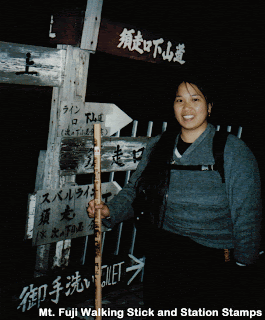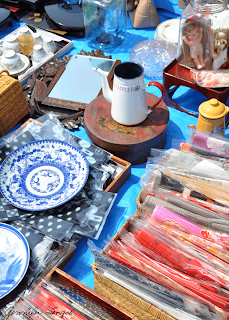
It’s that time of year again, Fuji-san climbing season. Mt. Fuji is Japan’s highest mountain, with an altitude of 3,776 meters (12,388 feet). Since snow is present on the peak from September to June, the official climbing season is from July 1 until Aug 27.
Fuji-san is located on the border of Yamanashi and Shizuoka Prefectures. Some climbers chose to hike the picturesque lower level, starting in Fujiyoshida all the way to the op. However, most people decide to go by car or bus to the halfway point and continue on foot from there. One of the advantages of climbing from the Fujiyoshida side (Yoshidaguchi Trail) is that even if you don’t make it to the top by day break, barring clouds, you can still see the sunrise from places along the trail.
Fuji-san is a fairly strenuous climb and you should be in some shape for the hours of climbing as well as severe changes in elevation and temperature. Many people are affected by the lack of oxygen at the summit. Depending on one’s physical fitness, it may take anywhere from four to 10 hours to ascend from the Fifth Station to the summit and another 2.5 to 5 hours to descend back to the Fifth Station. The trails up and down the mountain are not the same. Make sure that you know which Fifth Station from which you came; the most common one is the Yoshidaguchi Route.

Mountain Safety Tips. The Climbing Safety Guidance Center is located on the Sixth Station and a First Aid Center is located at the Seventh Station, but the latter is only open from July 19 to Aug 22. Be aware of falling rocks and never wander from the trail. It is not recommended to climb the mountain in the off-season due to bad weather, lack of emergency support, and limited bus service.


· Get a calligraphic stamp from the summit shrine.
· Walk around the summit crater (about 1.5 hrs).
· Mail letters from the post office.
· Call a friend a public phone at the highest point in Japan.

· Toilet paper (instead of tissue paper, which will not dissolve)
· Layered clothing (t-shirt, sweater, heavy jacket)
· Light pocket rain coat
· Sturdy shoes
· Warm gloves
· Hand sanitizer or wipes for after using the toilet
· Flash light and extra batteries (I paid ¥3000 for six C-sized batteries on the mountain. There are no electrical outlets on the mountain; bring spare batteries for digital cameras.)
· At least 1 liter of water and snacks (food is available along the mountain, but expensive – e.g. ¥1000 for ramen)
· Sunscreen, sunglasses, and a hat
· Cash for the return trip, souvenirs, and food (the climbing stick is about ¥5000 if you decide to get it stamped at all hut locations)

What I wish someone would have told me the first time I climbed Mt. Fuji:
· Cut your toenails. Yes it sounds odd, but if you have long toenails and improper hiking shoes, the decline of the mountain causes unnecessary pressure on the front of your feet when you descend the mountain. So what … well, it results in bruising of one’s toenails which will later pop off entirely. (I am speaking from experience.)
· Cover your mouth and nose. After prolonged exposure to the red and black dirt, one will notice that reddish-black dirt will be emitted when blowing one’s nose and coughing up phlegm.
· While using the toilet, don’t look down! For obvious reasons, there is no plumbing on the mountain. Save yourself the disgust and avoid looking at what others deposited before you.
· Learn to use a squat toilet. This applies for both men and women. Toilets on the mountain side are basically plywood over a hole.

Make sure you know what time your tour bus leaves and allow yourself enough time to descend the mountain. If by chance you miss your tour bus there are other options available.
· Option 1: Take the direct Mt. Fuji Chuo Express Bus from Mt. Fuji’s Fifth Station to Shinjuku Bus Terminal (about ¥2600). These buses leave at 13:00, 14:00, and 15:00.
· Option 2: Take the direct Fujikyu Bus from Mt. Fuji’s Fifth Station to Kawaguchiko Station(about ¥1700) and then transfer to a Chuo Highway Express Bus that takes you to Shinjuku Station (about ¥1700)
· Option 3: Take the direct Fujikyu Bus from Mt. Fuji’s Fifth Station to Kawaguchiko Station(about ¥1700) and then take a train to your destination. (Make sure to have an English-Japanese train map with you because English might not be available on the train.)
- Train Option A: Fujiyoshida Direct Express (Chokutsu Kyuko) to Shinjuku (about 2 hrs 06 mins)
- Train Option B: Fujiyoshida (Fujikyu Line) to Otsuki Station (about 50 minutes) switch to JR Chuo Line to Shinjuku Station (about 1 hr 40 mins)
Lastly, remember to carry your own trash down the mountain. There are no public trash facilities on the mountain.
Mt. Fuji Climbing Information
http://www.city.fujiyoshida.yamanashi.jp/div/english/html/climb.html
Mt. Fuji FAQs
http://www.city.fujiyoshida.yamanashi.jp/div/english/html/climbing_faq.html
Fujiyoshida City Website
http://www.city.fujiyoshida.yamanashi.jp/div/english/html/index.html
















































